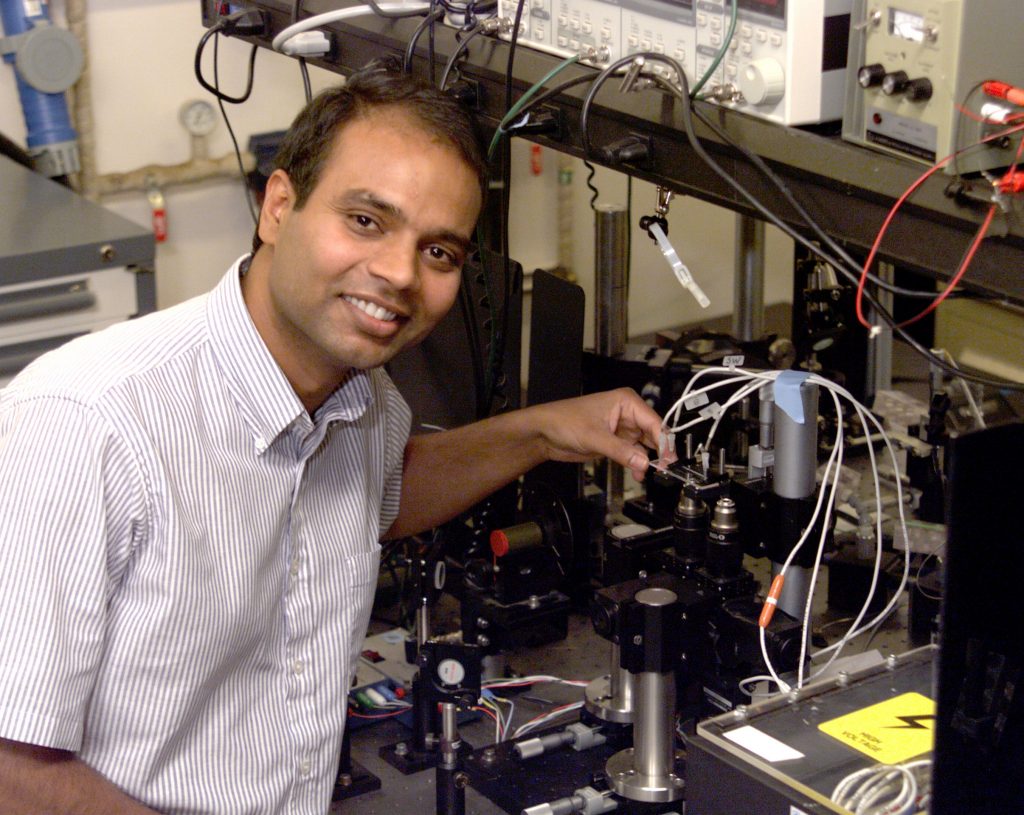
ALBUQUERQUE, N.M. — The next generation of microsystems may be like nothing anyone has ever seen.
Researchers at Sandia National Laboratories, a Department of Energy (DOE) national laboratory, are pursuing a revolutionary approach to building microsystems in which functions found in biological and nanoscale systems are combined with manufacturable materials. The ultimate result may be the first-ever programmable Molecular Integrated Microsystems (MIMS) devices that can be used for rapid chemical and biochemical analysis in sensors and encoded optical interconnects that can route optical energy on demand.
The research, funded internally as a Laboratory Directed Research and Development (LDRD) Grand Challenge, is led by Sandia researchers Terry Michalske and Len Napolitano.
“A programmable system is a new vision for microsystems,” Michalske says. “Our goal is to be able to reconfigure the architecture and tune the functions of microsystems, on-the-fly. This approach combines new developments in biotechnology and materials science to provide the methods needed to control materials and manipulate molecules at the nanometer scale. The ability to manipulate nanoscale structures is at the heart of the next revolution in programmable microsystems.”
Over the past decade Sandia has taken a pioneering role in the movement from traditional macroscale components and devices to fully miniaturized engineering systems. However, Michalske says that “we are now taking advantage of microscale addressability to locally control materials properties and molecular interactions within the microsystem itself.”
The MIMS grand challenge was initiated two-and-one-half years ago with the goal of developing the technical basis for the next generation of biochemical analysis and integrated optical microsystems. The biochemical analysis portion of the project is focused on new approaches to sort and separate small quantities of proteins in complex biochemical mixtures using the “ProLab — Sandia’s on-chip protein lab. The “ProLab will preconcentrate dilute protein samples and do on-chip biochemical separations, similar to what Sandia’s “chem-lab-on-a-chip,” formally called” Chemlab™, does with deadly chemicals.
“The ability to rapidly analyze protein signatures is a critical component of Sandia’s approach for detecting and mitigating bio-threats,” Napolitano says. “Traditional methods for analyzing the protein signatures involve labor-intensive and time-consuming techniques such as multidimensional chemical separations. Using the technologies developed in the MIMS, the team has already demonstrated that key components of protein analyses can be completed in a matter of minutes.”
The programmable optical interconnect objective of MIMS is to write new optical paths, “on demand.” The MIMS team has already demonstrated the ability to route on-chip optical signals in a programmable fashion. This new capability to create optical connections has important implications for spectroscopic analysis in chip-based chemical and biological analysis and may lead to new ways to control the access of information in weapons systems or secure data networks.
Napolitano notes that the MIMS project has already had several successes. The researchers can reconfigure a microfluid channel in real-time and can use electrical signals to manipulate proteins within those channels. In fact, some MIMS technologies are already licensed for commercial use while others are in various stages of negotiation.
“Our work over the past couple of years has brought us closer to our goal of building workable MIMS,” Napolitano says.
This fiscal year the goal is to build and demonstrate complete architectures and use science understanding to extend and increase programmable capabilities.
The MIMS grand challenge project received high praise from its external advisory panel that is made up of members representing universities, National Institutes of Health, Department of Defense, National Science Foundation, and DOE. The panel noted that, “At this stage of the project you have a terrific technology. What you are doing with this program is important science and promising technology.”
“We believe there have been some very significant accomplishments thus far,” the panel said in a report. “Further, we were impressed with the talent of the technical people that presented to us, as well as your breadth of understanding of what others are doing in this field. We feel that you have the promise here to wow biologists.”